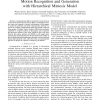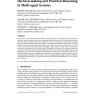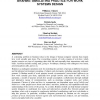16 search results - page 3 / 4 » Group recognition through social norms |
ICRA
2006
IEEE
14 years 22 days ago
2006
IEEE
— Communication skill is essential for social robots in various environments such as homes, offices, and hospitals, where the robots are expected to interact with humans. In thi...
CHI
2009
ACM
14 years 7 months ago
2009
ACM
Territoriality, the expression of ownership towards an object, can emerge when social actors occupy a shared social space. In the case of Wikipedia, the prevailing cultural norm i...
LOGCOM
2002
13 years 6 months ago
2002
paper, we present an abstract formal model of decision-making in a social setting that covers all aspects of the process, from recognition of a potential for cooperation through t...
IJMMS
1998
13 years 6 months ago
1998
A continuing problem in business today is the design of human-computer systems that respect how work actually gets done. The overarching context of work consists of activities, wh...
PAMI
2011
13 years 1 months ago
2011
—This paper introduces a novel contextual model for the recognition of people’s visual focus of attention (VFOA) in meetings from audio-visual perceptual cues. More specificall...



